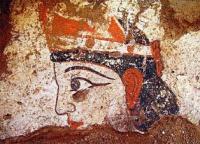You are here
Akshakhan kala ancient settlement.

Ancient settlement Kazaklyzhatkan kala.
“They (the inhabitants of Khorezm) counted the years from the beginning of the settlement (of their country), which took place 980 years before Alexander, and then began to count the years from the arrival of Siyavush, the son of Kaykus, to Khorezm, and the accession of Keikhusrau and his descendants there, who moved to Khorezm and extended his power to the kingdom of the Turks"
Abu Reyhan Biruni. "Monuments of the past generations".
Ancient settlement Kazakly-yatkan.
The Akshakhan kala settlement (Kazaklyzhatkan kala, Kazakly-yatkan) is located on a natural hill 100.3 meters above sea level, located in the western part of the Daganyoldy sands, 5.8 kilometers to the east and slightly south of the village of Khanyap, 15.3 kilometers by north and slightly west of the village of Beruni, 10.1 kilometers from the right (eastern) bank of the Amu Darya River in the Beruninsky region of the Republic of Karakalpakstan.
Akshakhan kala settlement (Kazaklyzhatkan kala), a large settlement, rectangular in plan, with an area of about 42 hectares. Walls of square raw bricks (40 - 42 x 40 - 42 x 10 - 12 cm) with rectangular towers have been preserved around the settlement.
In the northern corner of the monument there is a rectangular citadel with an area of about 13 hectares, around which there is also a fortress wall with rectangular towers, a proteikhism and a moat. The entrance to the settlement from the south-east and south-west sides is protected by the gateway labyrinths.
Inside the citadel, there are three hills: the central one (40 x 30 meters), the western one (90 x 37 meters) and the northern one (50 x 54 meters). Pottery is typical for the 4th - 3rd centuries BC. e. There is some reason to believe that Kazaklyzhatkan kala may have cultural layers of the middle of the Ist millennium BC. e.
The settlement was discovered in 1956 and entered into scientific circulation under the name Kazakly-yatkan. Among the local population, another, probably more ancient name of the monument, Akshakhan-kala, has also survived.
The excavations, begun in 1995, continue to the present day, made it possible to establish that this is the largest settlement of ancient Khorezm and put forward the assumption that it was here that the capital of Khorezm was located after its secession from the Achaemenid empire.
Inside the settlement there is a "holy town" surrounded by powerful fortress walls, in the center of which there is an unusual structure, defined as a mausoleum, where the remains of the first kings of Khorezm could have been buried.
The northwestern part of the "holy town" is occupied by the temple palace, where wall paintings were discovered. This is a portrait gallery of the royal dynasty with images of kings and, possibly, members of their families.
Inside the temple, a painted clay sculpture and lush architectural decor were found, made of clay and alabaster and having a multicolored painting on alabaster priming. In a number of cases, it was established that some details of the architectural decor were covered with a thin gold leaf.
All these findings make it possible to assert that unique artistic values are buried in the depths of the ancient ruins of Kazakly-Yatkan. In total, 45 fragments of painting were found, on which images of one or several characters were preserved. In 36 cases, the surviving painting represents breast portraits.
Analysis of the entire amount of data associated with fragments of painting in this part of the corridor made it possible to establish that the entire plane of the inner wall of the northern half of the western corridor was divided by double solid lines into rectangular cells located in at least three tiers.
Each cell contained an individual ore portrait. All portraits are made according to the same canon: the torso is face-to-face, the head is in profile and is turned mainly to the left. However, there are also a few cases when the head was depicted in profile to the right.
A similar manner (the so-called "ancient Eastern") of the image of the ruler is noted on the coins of the kings of Parsa from the 1st century. BC, on the coins of the Indo-Parthian rulers, starting from the 1st century. AD, as well as on the coins of the Kushan, Sassanids and Ephthalites.
All the characters in the gallery - beardless and beardless, with lush hair, black thick hair smoothly combed from the forehead back and covering the neck, but leaving open ears, painted red - is a completely unusual and unparalleled detail.
The depiction of beardless rulers in the art of ancient Khorezm is no exception. The same portraits of beardless kings are found on some types of Khorezm coins, in particular on the earliest of them, the so-called “nameless ruler in kulakh” coin.
The first signs of the presence of ancient paintings in the temple were discovered in 2004 - 2005.
Geographic coordinates of the ancient settlement Akshakhan kala (Kazaklyzhatkan kala, Kazakly-yatkan): N41 ° 49'35.56 "E60 ° 43'04.50"
Authority and photos:
Vadim Yagodin.







